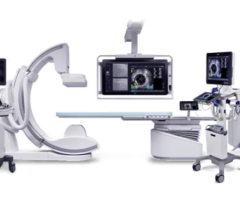
Soothing lighting and sound help patients, giving them some control over their environment and allowing them to relax more than in a standard cath lab setting.
In as much as the environment in which you live can affect your quality of life, so can the environment in which someone receives medical care affect patient outcome – at least in theory.
Healthcare facilities are now putting that theory to the test by designing catheterization (cath) labs and interventional suites that combine design and technology to create a comfortable experience for patients and staff.
The notion of calming the patient to help procedures progress more smoothly is not novel, but what is new is the way patients are being sedated, often without medication. Philips Healthcare is embracing and building on this concept with its Ambient Experience suites, which are rooms that integrate architecture, design and enabling technologies, such as lighting, sound, projection and RFID, to allow patients to personalize their environment and wrap themselves in a relaxing ambience.
Philips recently installed the Ambient Experience suite in the cath lab at Fairview Clinic, one of the hospitals in the Cleveland Clinic Health System. The room has been created as an interactive, people-focused healthcare environment that combines design and technology to create a more comfortable experience for patients and staff, potentially increasing operational effectiveness.
Diagnostic & Invasive Cardiology (DAIC) spoke with Victor Hall, regional vice president, Cardiac Services, Fairview Clinic, Cleveland Clinic Health Systems, Western Market, about how the new environment has impacted patient outcome and what has been the clinicians' response.
DAIC: What are some of the key design features that create this comfortable experience?
Victor Hall (VH): What we wanted to do was to take a different approach in the design of our facility and have a patient-centric focus. When I saw the Ambient Experience concept, I knew this would be another aspect that would fit well with our theme. Philips also helped to put a focus on de-cluttering the environment with special attention paid to storage and cabinets, and even things like waste receptacles. Plus having curves in the room, as opposed to corners, discourages clutter and gives the room a softer look. We also took the time to work together to evaluate our workflow to make sure there were appropriate space and access and room for staff to move freely about the room.
Of course the soothing lighting and sound that goes into these projects really helps patients as well, by giving them some control over their environment and allowing them to relax more than in a standard cath lab setting. Everything the Philips Ambient Experience offered was at the core of what we were trying to accomplish and that is to soothe and clam the patient.
When you’re a cath patient, you’re in a very compromising position. During prep your legs are hanging out, your chest is exposed and your groin may also be exposed. In a typical setting there are always people in the control room. What’s really nice is that with a push of a button, the glass goes opaque and you have instant privacy for the patient.
DAIC: How are the technologies designed to create this comfortable experience? For example, there is the special lighting and a touch screen PC.
VH: Technology is used as an ‘enabling tool’ with the Ambient Experience – the touch screen allows the patient and staff to customize the environment. Leading edge lighting technology and strategies are incorporated to provide both aesthetics (dynamic lighting) and function (minimize glare).
DAIC: How does this increase operational effectiveness compared to a conventional cath lab?
VH: We have found that not only do our patients find the room a soothing environment, our cardiologists and staff like it as well. We have some cardiologists that program or request their preference before a case begins. The patient monitors at the scrub sink are a plus as well, since it allows the cardiologist to check on their patient and get their head in the game before entering the lab.
Benefits to the clinicians were a pleasant surprise for me. Usually cardiologists don’t make a big fuss one way or the other, but the cardiologists that use it love it. I’ve got doctors vying for the room all the time now. Plus the doctors tell me that they look at their patients and they can tell from their eyes that they are a lot calmer. And they say in turn, that makes them calm too.
DAIC: Does the ambience actually reduce the need for sedation and repeat examinations?
VH: One key objective is to relax the patient, which in turn also helps relax the staff and family members. Any time people are more relaxed, they tend to cooperate and require less intervention such as anesthesia. A cooperative patient is also more likely to get a valuable exam done more quickly and accurately. Philips has trend data that children in a scanning environment can often proceed without sedation, and there are similar findings in the MR environment. They are currently in the process of methodically quantifying the impact in the cath lab environment.
DAIC: How does the Ambient cath lab suite affect patient outcomes?
VH: Philips is currently in the process of working with The Center for Healthcare Design to develop strategies for evaluating this.


 December 20, 2023
December 20, 2023 








